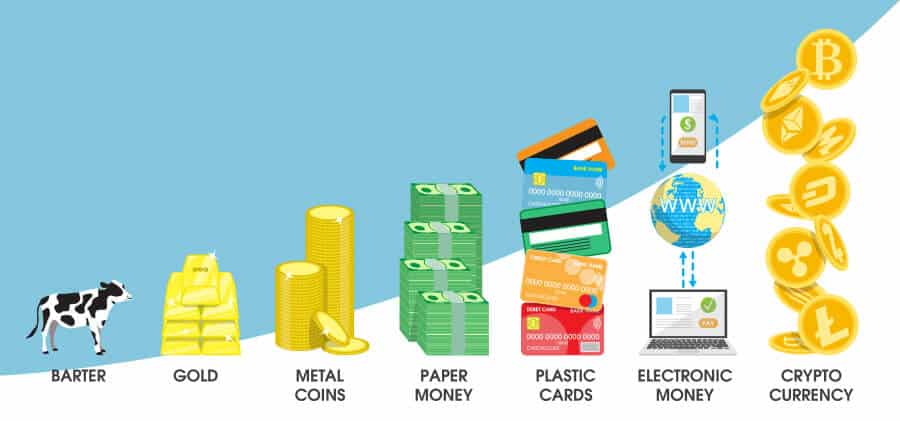Cryptocurrency has been around for almost 12 years. In 2008, an unknown person or group of people going under the name Satoshi Nakamoto invented it. It made the headlines; and many people bought some, then Soo forgot about it while it grew in value. Today, a single Bitcoin is worth almost $12,000, and there are many other cryptocurrencies out there. Many people still don’t understand the concept of a digital money that’s instant, private, and free from bank fees. However, in an increasingly cashless world, cryptocurrency may become the main currency we use, which will change everything.
What is Money?
Before we delve into the creation of cryptocurrency, it is important to understand how money was created in the first place. Humans are social creatures, so we have always traded and bargained. Back in 5,000 BCE, people began using metals to create coins that were worth a certain amount. Basically, we leveled up from “I owe you a favor for giving me this apple,” to “here is a coin that this apple is worth.” While in the past, money was based on actual objects of value, such as gold, today it is created differently.
Today, money is created by private corporate banks that offer loans to people and governments. The money is created by these banks out of nowhere. This money is essentially debt, and this cycle is decidedly endless. Certain banks have restrictions on how much money they can create, while others can create money at will and without limit. Since their job is to keep the economy stable, they must follow certain principles when creating money.

What is Cryptocurrency and How is it Created?
Cryptocurrencies are digital or virtual currencies that are secured by cryptography. This makes it impossible for them to be counterfeited or double-spent. Many are decentralized networks based on blockchain technology, which is a distributed ledger enforced by a disparate network of computers. They are also not issued by any central authority, making them immune to government manipulation or interference.
These virtual currencies are considered alternative, because they exist outside the bounds of state monetary policy. Most simply put, cryptocurrencies are a digital means of exchange created and used by private individuals or groups. They use cryptographic protocols, which are extremely complex code systems that encrypt the transfer of sensitive data, securing their units of exchange.

Just like gold, cryptocurrency is mined. However, it is done digitally. The so-called miners serve as record-keepers for these communities as well as indirect judges of the value of the currency. Mining requires vast amounts of computing power and highly technical methods. Since most cryptocurrencies have a finite supply, which is a key guarantor of value, miners receive fewer new units per new chainblock as time goes on.
Just like there isn’t an endless amount of gold in a given mine, there is only so much of each cryptocurrency. This makes this currency more similar to precious metals than fiat currencies. Fiat currencies are government-issued, and they aren’t backed by actual commodities. This allows banks to create new money as needed and makes their supply unlimited.
Bitcoin and Other Cryptocurrencies
While Bitcoin was the first to be widely used, hundreds of cryptocurrencies exist. In fact, more are created regularly. It is important to clarify that cryptocurrencies can be exchanged for fiat currencies in special markets. This means that these virtual currencies have a viable exchange rate with US dollars, British pounds, European Euros, Japanese yen, and other major world currencies.
With so many cryptocurrencies out there, some can get a little silly. But this does not make them any less valuable. In December 2013, Dogecoin was created as a joke. Dogecoin was based on the popular shiba inu meme on social media. The silliness was what made it popular, and in January 2014, a month after creation, it reached a capitalization of 60 million USD. As of February 2018, over 113 billion coins had been mined.
Today, there are seven major cryptocurrencies that InvestorPlace advises interested parties to invest in. These include Bitcoin (BTC), Zcash (ZEC), Ripple (XEC), Basic Attention Token (BAT), Chainlink (LINK), Synthetix Network Token (SNX) and DxChain Token (DX). Of course, other cryptocurrencies are also worth checking out and can appreciate significantly over time.
Predictions

Financial and currency experts have been fascinated by cryptocurrencies from the start. Research has been done to see what the future will hold for them. The results are pretty surprising – Bitcoin is predicted to hit $1 billion by the end of 2020. Also, it is expected that everyone will shift to using cryptocurrencies without even knowing it. Businesses are expected to incorporate digital currencies to cut costs while customers and clients keep using traditional methods of transaction.
At the moment, cryptocurrencies are independent of governments. However, many believe that governments will soon adopt the blockchain technology of virtual currencies. The Estonian government, for example, has already done so to a certain extent, and others are expected to follow suit.
It is also a real possibility that, as the value of individual cryptocurrency rises, people will soon demand the ability to exchange them. Just as we can bring USD to a bank to get some Euros, Bitcoin users may soon expect to be able to get Dogecoin at a fair rate. This, along with other factors, may completely disrupt the banking and financial industries. Picture a future where people have cryptocurrency bank accounts and debit cards, and the ATM can directly issue Bitcoin.
The world we live in is constantly changing, and technology is a big factor in how we live. Cryptocurrencies seemed like a crazy thing when they emerged in 2008 but have since become more mainstream as well as more valuable. Bitcoin, as well as other cryptocurrencies, are expected to change the way the banking, trading, and financial industries function. While it is a little late for the average person to invest in the larger cryptocurrencies such as Bitcoin, there are many still in their early stages. These virtual currencies, which have more in common with gold than the cash in your pocket, will impact all of our lives in a matter of time – if they haven’t done so already.
Photos: Shutterstock
More articles from the author:
Support us!
All your donations will be used to pay the magazine’s journalists and to support the ongoing costs of maintaining the site.
Share this post
Interested in co-operating with us?
We are open to co-operation from writers and businesses alike. You can reach us on our email at [email protected]/[email protected] and we will get back to you as quick as we can.










